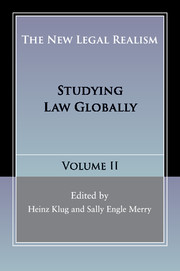Book contents
- Frontmatter
- Dedication
- Contents
- List of contributors
- Preface to The New Legal Realism, Volumes I and II
- 1 Introduction
- Section I The Globalization of Law
- 2 African Constitutionalism From the Bottom Up
- 3 Human Rights Monitoring, State Compliance, and the Problem of Information
- 4 Intellectual Property and the Creation of Global Rules
- Section II The Global Transfer of Norms
- Section III global institutions and the changing roles of judges and lawyers
- Section IV Global Justice
- Index
- References
3 - Human Rights Monitoring, State Compliance, and the Problem of Information
from Section I - The Globalization of Law
Published online by Cambridge University Press: 05 May 2016
- Frontmatter
- Dedication
- Contents
- List of contributors
- Preface to The New Legal Realism, Volumes I and II
- 1 Introduction
- Section I The Globalization of Law
- 2 African Constitutionalism From the Bottom Up
- 3 Human Rights Monitoring, State Compliance, and the Problem of Information
- 4 Intellectual Property and the Creation of Global Rules
- Section II The Global Transfer of Norms
- Section III global institutions and the changing roles of judges and lawyers
- Section IV Global Justice
- Index
- References
Summary
How does ratifying a human rights convention affect a state's human rights compliance? This critically important question has inspired considerable scholarship in the past decade, some of it using sophisticated statistical techniques and a nuanced political analysis. Although the earliest work, by Oona Hathaway (2002), indicated that ratification had little impact on compliance based on a large, quantitative study, Beth Simmons's more recent quantitative work shows that there are improvements in compliance in certain kinds of states, based in part on the role of domestic actors (2009). It is, of course, very hard to answer this question, since state behavior depends on a wide variety of considerations, interests, and actors with their own concerns and motivations. The promotion or neglect of human rights is determined by multiple factors, and ratification of a treaty and the effect of its associated monitoring process can only be one of many determinants of compliance.
However, from the perspective of New Legal Realism, this is a question that cannot be answered only in terms of the laws themselves or the formal procedures of monitoring through treaty body hearings (the meetings between country representatives and the small committee of experts charged with monitoring compliance with the treaty, called a treaty body). Instead, it requires an analysis of the content of expectations, the political and economic situation of the countries under investigation, and the willingness or resistance of a country to accept treaty obligations. I argue that ethnographic observation of hearings and the analysis of texts and contexts of committee hearings on states’ compliance with the terms of human rights treaties show that states differ in their enthusiasm for the various obligations in human rights treaties. These hearings offer clues to states’ willingness to comply with the treaties and areas of resistance. Compliance may well be related to the situated responses of countries to the particular demands of treaty body committees. This is an approach that can be productively applied to understanding forms of quantification and indicators more broadly (Merry 2016).
- Type
- Chapter
- Information
- The New Legal RealismStudying Law Globally, pp. 32 - 51Publisher: Cambridge University PressPrint publication year: 2016



